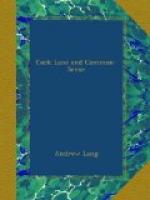Thus the dark ages do not, as might have been expected, provide us with most of this material. The last forty enlightened years give us more bogles than all the ages between St. Augustine and the Restoration. When the dark ages were over, when learning revived, the learned turned their minds to ‘Psychical Research,’ and Wier, Bodin, Le Loyer, Georgius Pictorius, Petrus Thyraeus, James VI., collected many instances of the phenomena still said to survive. Then, for want of better materials, the unhappy, tortured witches dragged into their confessions all the folklore which they knew. Second sight, the fairy world, ghosts, ‘wraiths,’ ‘astral bodies’ of witches whose bodies of flesh are elsewhere, volatile chairs and tables, all were spoken of by witches under torture, and by sworn witnesses. {31} Resisting the scepticism of the Restoration, Glanvil, More, Boyle, and the rest, fought the Sadducee with the usual ghost stories. Wodrow, later (1701-1731), compiled the marvels of his Analecta. In spite of the cold common-sense of the eighteenth century, sporadic outbreaks of rappings and feats of impulsive pots, pans, beds and chairs insisted on making themselves notorious. The Wesley case would never have been celebrated if the sons of Samuel Wesley had not become prominent. John Wesley and the Methodists revelled in such narratives, and so the catena of testimonies was lengthened till Mesmer came, and, with Mesmer, the hypothesis of a ‘fluidic force’ which in various shapes has endured, and is not, even now, wholly extinct. Finally Modern Spiritualism arrived, and was, for the most part, an organised and fraudulent copy of the old popular phenomena, with a few cheap and vulgar variations on the theme.
In the face of these facts, it does not seem easy to aver that one kind of age, one sort of ‘culture’ is more favourable to the occurrence of, or belief in, these phenomena than another. Accidental circumstances, an increase, or a decrease of knowledge and education, an access of religion, or of irreligion, a fashion in intellectual temperament, may bring these experiences more into notice at one moment than at another, but they are always said to recur, at uncertain intervals, and are always essentially the same.
To prove this by examples is our present business. In a thoroughly scientific treatise, the foundation of the whole would, of course, be laid in a discussion of psychology, physiology, and the phenomena of hypnotism. But on these matters an amateur opinion is of less than no value. The various schools of psychologists, neurologists, ‘alienists,’ and employers of hypnotism for curative or experimental purposes, appear to differ very widely among themselves, and the layman may read but he cannot criticise their works. The essays which follow are historical, anthropological, antiquarian.




